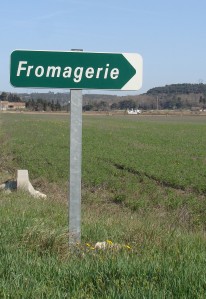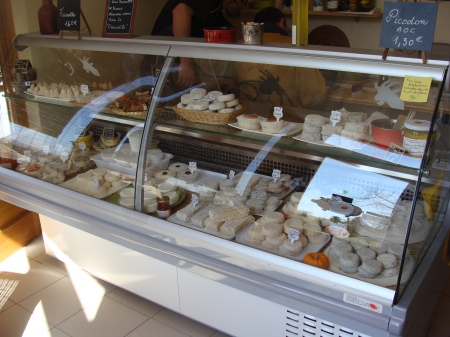Raphael and I have been trying to have a ‘date night’ for a while now. But between the unexpected work in the fields, the kids, the work on the house and numerous other expected and unexpected responsibilities, we’ve been unable to make that date.
We made a plan, Raphael and I. After the kids were in bed, I would join him in the fields on his tractor. So at about 8:30, I changed my flimsy, gold sandals, so inappropriate for a farm (Gotta love inappropriate shoes.) for the thick, practical black pair I bought at the marché the first time I visited the winery. I grabbed a cold beverage (Wish I could say it was a chilly rose but in fact it was a coke.) and climbed up the path towards the chapel and the sound of his tractor.
He was headed towards me a few rows away, high up on the green monster spitting out puffs of copper that smelled oddly sweet in the evening heat. Seeing Raphael on the tractor always makes me think of the country song, “She thinks my tractor’s sexy.” I have no idea who sings it and have never had Raphael listen to it but there is something about a man on a tractor. He waved me over and I climbed up the metal ladder amidst puffs of copper and waves of heat from the engine.
Tractors are one seater’s so I stood next to him, hung on to the bar spanning the top and leaned against the metal tank holding the copper. It was hot, smelly, loud and bumpy but I have to admit, there’s something quite romantic about riding a tractor with a man through vineyards at dusk. The sun was setting at the foot of the fields and the building clouds were tinged pink in its glow. Tractors are really high up so the view is extraordinary. I could see to the Vercors mountains and the span of fields leading to their base – the yellow sunflowers, blue lavender, and green vines a patchwork in the dying sun. Despite the noise, we managed to have the longest conversation in days. We shared the coke and discussed the kids, our summer plans, our current living situation and our future house. I was sent to apologize to neighbors having dinner in their garden next to the field we were treating. They are summer visitors and I barely know them but they didn’t hesitate to invite me for a drink and joke about me riding the tractor with my husband.
At one point, Raphael scooted back in his seat and told me to climb up in front of him to take control of the tractor. “Where,” I said noting the many gears and pedals clamored together in front of the seat. “There’s no room and I might bump one of those things.”
“No, don’t worry. Come on.” I swung my leg over the gears and settled my butt in the small space of seat between his legs. “Here,” he said letting go of the wheel. “You take this.”
“What! No! I can’t drive. I’ll crush the vines or flip us over.” I had heard stories about people being crushed under their tractors and it always worried me. I had already gashed my knee climbing up on the thing and banged my head against the bar when Raphael shifted gears jerked the tractor unexpectedly.
“No,” He said it like talking to one of the girls. “It’s just like driving a car.”
Tension climbing up my arms, I took hold of the wheel. I swerved the tractor a bit and Raphael took hold to straighten it. “See that circle knob on the front of the tractor?” He pointed out. “Keep that in the center of the vines and your good.” It’s harder than it looks, for me at least. The tractor is built to treat six rows at once spraying three on either side with wide-spread wheels in order to span one row of vines up the middle. The round knob is meant to be aligned with this center row. The problem is that each time the tractor hits a bump, and the fields are full of them, the wheel jerks to either side. It was at this moment that Raphael chose to inform me that the tractor has no brake. “Why?”
“I don’t know,” he shrugged that Gallic ‘that’s just the way it is’ shrug. “It’s old.”
At the end of the row he took the wheel in order to turn the thing around and head back down the next rows. The sun was almost set. Raphael turned on the headlights throwing a florescent orange glow over the vines. We finished the fields and headed back to park the tractor. Taking Raphael’s hand to walk back to the house, I thought, this was better than dinner and a movie. We talked, laughed, kissed and enjoyed each other’s company on top of a tractor in the middle of vineyards in the dying sun. I was reminded of our first summer together and felt free again.


























